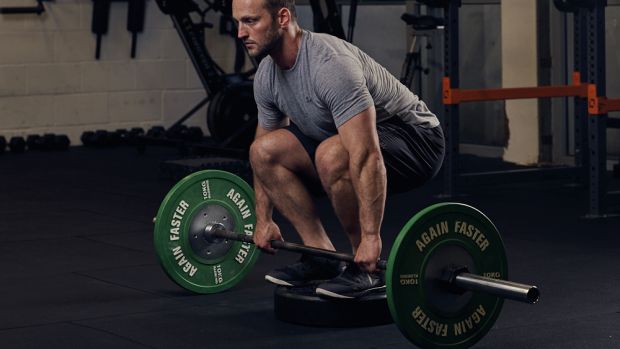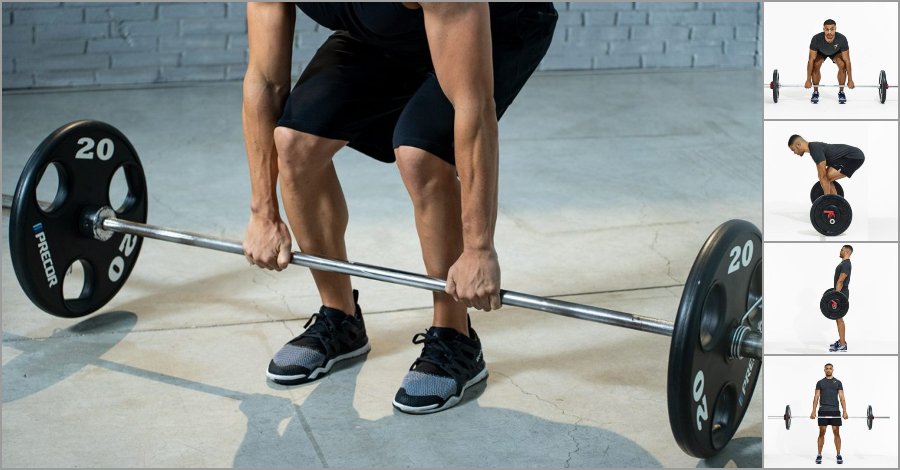The deadlift is simply personified and one of the best muscle-growing, strength-building, health-improving moves around. Performed safely, the deadlift will strengthen every bone in your body, challenge every muscle across your posterior chain and test your grip strength and core stability to the absolute max.
It will find any flaws that you need to address if you hope to lift heavy. For that reason, you should always start light, within your means, and build up the weight once your technique is flawless. It’s a great addition to the routine of anyone who’s guilty of just training their muscles on the front of the body, at the expense of those on the rear of the body, especially the lower back and hamstrings.
Doing so will result in an unbalanced physique and significant strength discrepancies between synergistic muscle groups that leads to injury. But the barbell deadlift is the best remedy for this, the exercise works the entire posterior chain of muscles from your neck to your hamstrings, and activate more muscle fibres than doing similar moves such as hex-bar deadlifts or glute raises.

As a big compound lift, it also prompts your body to release growth hormones and testosterone, further increasing your bone density and muscular hypertrophy. The deadlift is one of the three core exercises in any strength training plan, along with the barbell squat and the bench press.
With so many variations to activate different muscle groups, it’s a great strength builder – you will find that you progress through the weight fairly quickly. You’ll fire up lots of muscle fibres during the move – much more important than a quick arm pump – and racking up big numbers on the deadlift will boost your confidence in the gym too.
Follow our tips and aim for a double bodyweight deadlift.
How To Deadlift:

How to:
- With your feet flat on the floor, bend at the knees and grab the bar with hands shoulder-width apart.
- You have two grip choices: a double overhand grip or a reverse grip, where one hand grips the bar overhand and the other underhand.
- The reverse grip will allow you to lift heavier. Always squeeze the bar as hard as you can, especially on heavier sets, before the bar leaves the floor.
- Keep your head in a neutral position by looking forwards with your eyes fixed to a spot on the ground, 2-3m ahead of your feet.
- Keep your chin up so your head stays in the best position for lifting.
- Keeping your back straight and your head facing forward throughout, lift the bar using your legs and driving your hips forward.
- The deadlift should be a fast and powerful lift using your legs and glute strength.
- Drive upwards as explosively as possible.
- Aim to maintain a strong spine from the beginning of the lift to the end.
- Do this by keeping your chest up to prevent your torso from hunching forwards over the bar.
- Your shoulders should remain slightly in front of your hands until the bar passes a mid-thigh level, at which point you want to retract your shoulder blades for a strong and stable torso.
- Pull your shoulders back at the top of the move, then carefully lower the bar to the ground.
Deadlift Form Tips:

The deadlift is one of the best total-body moves for building muscle and burning fat, but only if you do it right.
Keep your head neutral:
- You want to keep your head in a neutral position throughout the lift.
- This is achieved by looking forwards with your eyes fixed to a spot on the ground about two to three metres ahead of your feet.
- And focus on keeping your chin up to keep your head in the best position for lifting.
Think chest and shoulders
- You want to maintain a strong spine from the beginning of the lift to the end, and the best way to achieve this is to keep your chest up throughout to prevent your torso hunching forwards over the bar.
- Your shoulders should remain slightly in front of your hands until the bar passes a mid-thigh level, at which point you want to retract your shoulder blades for a strong and stable torso.
Keep your core braced
- You need to keep your abs braced throughout the entire move to maintain an arched lower back and to keep your entire body strong and stable, especially when attempting heavier lifts.
- Engage your core from the very start so your abs are tensed as you squat down to grip the bar.
- As you are about to lift the bar breathe deep into your belly, hold your breath, and brace your abs hard like you’re about to be punched in the stomach.
Try to move explosively
- Standing with your feet shoulder-width apart, grasp the bar with your hands just outside your legs.
- Lift the bar by driving your hips forwards, keeping a flat back.
- Lower the bar under control – though once you get up to really heavyweights, it’s OK to drop it on your final rep.
Develop a strong grip
- Place your thumbs against the outer part of your thigh, and run both hands down until they touch the bar.
- This is your ideal hand position. As for your grip, you have two choices: a double overhand grip or a mixed grip, where one hand grips the bar overhand and the other underhand.
- The mixed grip will allow you to lift heavier, but make sure you switch hands regularly to prevent developing any muscular imbalances.
- Always ensure you squeeze the bar as hard as you can, especially in heavier sets, before the bar leaves the floor.
Romanian deadlift
Why: This variation shifts the emphasis to your hamstrings, making it an ideal accessory exercise to the standard deadlift.

How to:
- Stand tall with your feet shoulder-width apart, holding a barbell with an overhand grip just outside your thighs.
- Keeping a slight bend in your knees, bend forwards from the hips – not the waist – and lower the bar down the front of your shins until you feel a good stretch in your hamstrings.
Snatch-grip deadlift
Why: Because your grip’s wider in this move, you’ll need to move the bar through a larger range of motion, increasing the growth hormone hit. It’ll also prepare you for Olympic-style weightlifting.

How to:
- Hold a barbell with your hands roughly double shoulder-width apart.
- Push through your heels and keep your chest up as you drive forwards with your hips to lift the bar.
Deficit deadlift
Why: Lifting from a “deficit” – an artificially lower start position – will fix any weakness in your deadlift, forcing you to keep a flat back and engaged shoulders to get the bar off the ground. Use this as a “de-load” from regular deadlifts to carry on making gains.

How to:
- Stand on a weight plate or low box and grasp the bar.
- Engage your shoulders and take the strain, then lift the bar by driving your hips forwards, keeping a flat back.
Kettlebell swing
Why: This full-body move engages all the muscles of your posterior chain, but also teaches the explosiveness you need to do everything from throwing a punch to jumping onto a box.

How to:
- Swing the kettlebell between your legs with both hands, then pop your hips forwards to drive it up to head height, keeping your arms relaxed.
- Let the kettlebell swing back into the next rep – you don’t need to bend your knees much.

